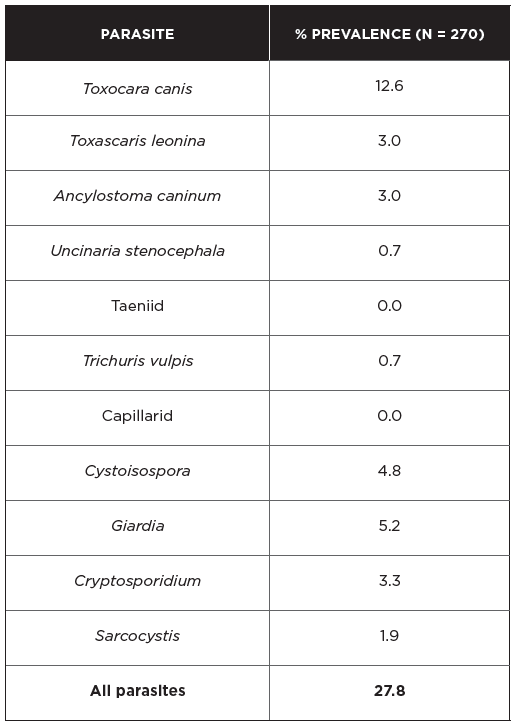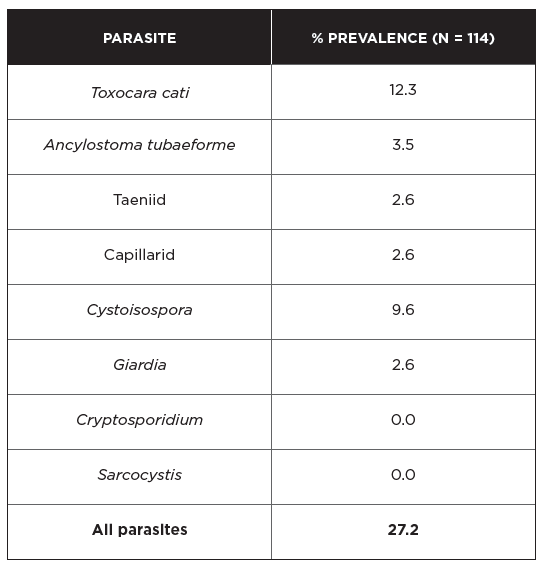Quebec
Regional prevalence data for gastrointestinal parasites, heartworm, fleas, and ticks for Quebec
Gastrointestinal parasites

The tables below show fecal flotation data from shelter animals and are therefore not representative of the expected parasite prevalence in pet populations that receive regular veterinary care. However, they do provide information on the types of parasites that pets may be exposed to in this region.
Based on sugar flotations and centrifugation of fecal samples collected from 270 shelter dogs, the most commonly observed parasites in dogs in Quebec are Toxocara canis, Giardia, and Cystoisospora (Villeneuve et al 2015). The complete fecal examination results are shown below.

Based on sugar centrifugal flotations of fecal samples collected from 114 shelter cats, the most commonly observed parasite in cats in Quebec are Toxocara cati and Cystoisospora (Villeneuve et al 2015). The complete fecal examination results are shown below.

The above prevalences in shelter animals are likely higher than what would be seen in the companion animal population, as these were largely young animals, and prevalence of helminths is expected to be lower in pets that receive regular veterinary care.
Heartworm
The heartworm endemic area is in southwestern Quebec. Monthly preventive should be administered from June 1st to November 1st.
The last systematic postal survey of heartworm in Canada was carried out in 2010. Of the 564 canine cases diagnosed, 41 (7%) were in Quebec. The survey data for Quebec are presented below alongside the postal survey from 2002 and IDEXX SNAP 4Dx data from 2013-2014 (Herrin et al 2017). Because the 2013-2014 SNAP 4Dx test results are not accompanied by information on confirmatory testing, we cannot draw firm conclusions when comparing this data to veterinarian-diagnosed cases from prior years. However, it does provide an estimate of heartworm prevalence that can help to establish a temporal trend.

The prevalence of heartworm infection appears to have increased in Quebec since 2002. Only 6 of the 41 diagnosed cases in 2010 were imported dogs or dogs that had traveled outside Canada. Once heartworm is successfully cycling in a region it is very difficult to eliminate because not all dogs will be placed on preventive medications and wildlife such as coyotes, foxes, and wolves are appropriate hosts and can act as a reservoir of infection. Climate change may be allowing for the geographic expansion of mosquito vectors as well and thus enhancing heartworm transmission. Since no patient history is provided for the 2013-2014 SNAP 4Dx data, it is unknown if the dogs testing heartworm positive were imported from other countries or had traveled to endemic countries. Regardless of original location of infection, the fact remains that a higher prevalence of heartworm-infected dogs in a region will increase the risk of transmission to other dogs in that area, making it crucial to detect and treat infections as soon as possible. This will also help to reduce zoonotic transmission of heartworm to people, which has been reported on 3 occasions – twice in Quebec and once in Ontario (Lagrotteria et al 2003, Kokta 2008).
Fleas
There are no prevalence data for fleas in Quebec, though based on experience, veterinary practitioners assess the prevalence as relatively high.
Fleas are not typically a problem year round. The at-risk period is generally May to October, though some households have experienced flea problems throughout the year.
Ticks
The tick season typically starts at the end of April and concludes by early December, but recall that Ixodes scapularis will be active any time the ambient temperature reaches 4°C, which occurs in many areas on some days throughout the winter. The most commonly found species in a passive tick surveillance program was I. scapularis by far (294/382), followed by I. cookei (the groundhog tick; 70/382) and Dermacentor variabilis (11/382) (Koffi et al 2017). Of the I. scapularis ticks recovered from companion animals, 193/2,044 (9.4%) on dogs and 122/892 (13.7%) on cats were infected with B. burgdorferi (Ogden et al 2010).
A map of Lyme disease risk areas in Quebec is available at: www.inspq.qc.ca/zoonoses/maladie-de-lyme
Data from a total of 115,636 Canadian dogs tested in 2013-2014 (Herrin et al 2017), compared to 94,928 samples in 2007 (from Incidence of Heartworm, Ehrlichia canis, Lyme Disease, Anaplasmosis in dogs across Canada as determined by the IDEXX SNAP® 3Dx® and 4Dx® Tests – 2007 National Incidence Study Results, IDEXX, Markham, ON) indicate that seroprevalence of tick-borne agents was as follows:

*A hyperendemic focus exists in southern Quebec, where seroprevalence is > 5%.
These data should be interpreted carefully as they indicate exposure and not necessarily current infection. Many dogs that seroconvert for B. burgdorferi do not develop clinical signs. In addition, the true prevalence of exposure within Canada may be lower than the reported estimates for several reasons: there is no evidence that confirmatory tests were done for any of the samples; the travel history of dogs is not given; and, in light of the very low prevalence of infection in most areas, some positive results may be false positive.
